Yarrow is a plant with a storied history. Adored for its beauty, and said to bring good luck, it’s also coveted as a food, and for the production of practical goods. Impressive stuff from what most people would consider a weed!
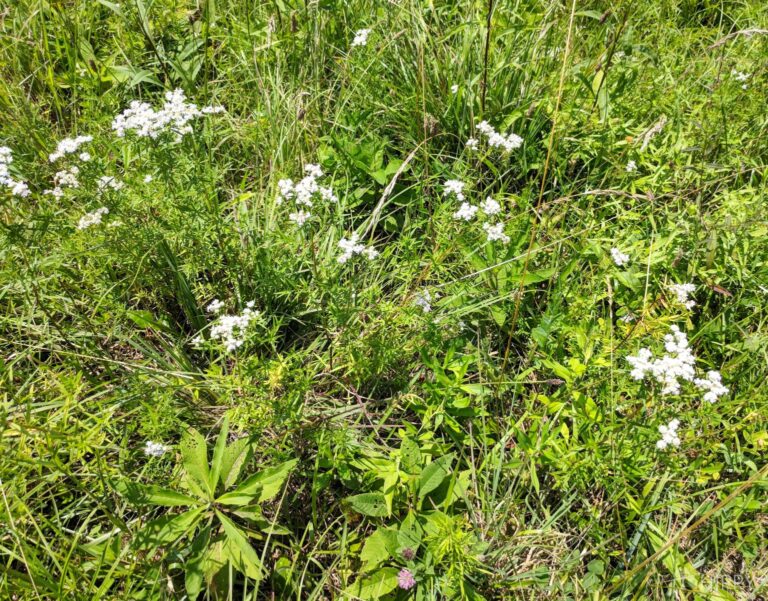
However, those dense clusters of tiny white and yellow flowers can be easily mistaken for other plants with similar blooms and leaves. Some of those imposters are shockingly dangerous!
If you’re out hunting for yarrow, this isn’t something you can afford to get wrong. To help you, I’ll tell you about common yarrow lookalikes below, and how to recognize them…
Table of Contents
1. Pignut (Conopodium majus)
The Pignut, known scientifically as Conopodium majus, is a perennial herbaceous flowering plant that belongs to the same family as celery, Apiaceae.
The Pignut has fine leaves and delicate stems which may make it easy to confuse with Yarrow at first glance, exacerbated by its tendency to grow in open woodland, hedges, thickets, grassland.
Pignut roots resemble a chestnut and are a favorite of many animals, particularly pigs who will root for it with relish.
However, there are specific features that can help you distinguish between these two: Unlike Yarrow, which has clusters of small, white flowers, Pignuts produce singular white flowers on longer stems.
Pignut leaves are also finely divided and distinct from Yarrow’s. The good news is that the tuber, or roots, can be eaten and is very tasty when cooked properly, making it a popular choice for foragers.
So, safety-wise, Pignut is as safe as Yarrow and mixing-up one for the other won’t be a catastrophe.
However, it’s important to be 100% sure of your ID since other lookalikes on this list might be confused for either and are decidedly less safe!
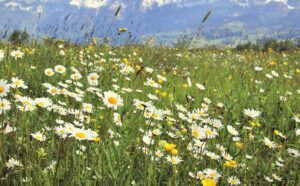
2. Mayweed Chamomile (Anthemis cotula)
Mayweed Chamomile, also known as Anthemis cotula, is an annual plant that has made its way to America where it grows in disturbed soils, grasslands, and along roadsides.
Basically anywhere there has been consistent human or livestock activity, this nasty flower can take root. And I say nasty because it is: Mayweed Chamomile is not a true chamomile at all.
And when crushed, the plant gives off a strong, unpleasant stink, totally unlike Yarrow.
But at first glance, you may mistake Mayweed Chamomile for Yarrow due to their similar flower structure. Both have small, white, daisy-like flowers with yellow centers.
However, the key difference lies in their leaves and, as mentioned, the scent. Mayweed Chamomile has fern-like leaves that are much more dissected than Yarrow’s.
Besides the unpleasant smell, it can also cause skin irritation in some people and is toxic if eaten. If ingested in large amounts, it may also cause persistent stomach bleeding. Not good!
You don’t need much incentive to keep away from this plant, but it’s best to learn how to identify it if only so you can eliminate it.
3. Wild Carrot (Daucus carota)
The Wild Carrot, or Daucus carota, is also known popularly as Queen Anne’s Lace for its bountiful umbels of delicate, small flowers.
Native to Europe and Asia and naturalized in the US, this plant grows well all-over, and particularly well in disturbed soils.
If you don’t pay close attention, you might confuse the Wild Carrot for Yarrow because of the flower structure: Both produce bunched, tight clusters of small, white flowers.
However, there are key differences that can help you spot differences between the two…
The Wild Carrot’s flowers form a generally flat-topped cluster, while Yarrow’s flowers form a more dome-shaped cluster, though the method of arrangement is similar viewed from beneath.
Additionally, the leaves of the Wild Carrot are feathery and finely divided (much like domestic carrots), and smell carrot-like when crushed or broken.
Lastly, look for Wild Carrot to occasionally produce a single red or dark-colored bloom in the middle of each cluster. The exact purpose of this single, bright flower is unknown to scientists, but it is a distinctive trait of Wild Carrot.
As you might have guessed, Wild Carrot is the ancestor of the cultivated carrots we all buy at the grocery.
And while the wild variant’s root is not as big, it is edible, nutritious, and generally safe to handle, but some sensitive people may experience skin irritation from contact with the plant’s leaves.
Caution: It’s crucial to correctly identify Wild Carrot before harvesting, as it closely mimics several dreadfully poisonous species, including Poison Hemlock!
4. Poison Hemlock (Conium maculatum)
Poison Hemlock, known scientifically as Conium maculatum, is one you must watch out for: this is one of the single most poisonous plants in the world, and one of the most common around the world… including, sadly, throughout North America.
I don’t exaggerate when I tell you this is one plant that’s extremely dangerous: All parts, from the roots to the seeds, contain toxic alkaloids that can cause death if ingested, usually following total respiratory failure.
Poison Hemlock can be mistaken for Yarrow since it has small, white flowers that cluster together in the same way. However, upon closer inspection, you’ll notice some big differences.
Poison Hemlock has larger flower clusters compared to Yarrow, and its stem is smooth with purple or reddish streaks or blotches, often visible when the plant is about to die.
This is in contrast to Yarrow’s rough, non-spotted stem. Also, unlike Yarrow, Poison Hemlock emits a distinct, foul odor when crushed.
Be warned: the alkaloid toxins in Poison Hemlock are deadly when ingested but also readily absorbed through the skin or even inhaled! Give this dangerous plant plenty of space and don’t touch it.
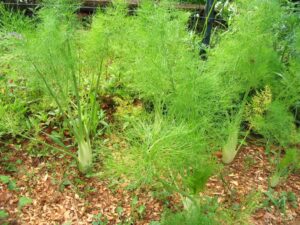
5. Sweet Fennel (Foeniculum vulgare)
Whew! Another safe lookalike plant, and a beloved edible one to boot! Sweet Fennel, Foeniculum vulgare, is a perennial herb that hails from the Mediterranean.
It’s quite easy to mistake it for Yarrow since it has similar feathery leaves and clustered flowers.
But Sweet Fennel has an upright, branching habit and typically grows 3 to 5 feet high. Its leaves are also intensely aromatic and yellow-green, while its tiny flowers are all-over yellow; a key distinguishing feature from the white blooms with yellow centers of Yarrow.
Another distinction is the scent: Sweet Fennel smells anise-like (like licorice) when crushed, unlike Yarrow.
As expected, Sweet Fennel is safe to handle and consume. In fact, Sweet Fennel is commonly cultivated in gardens for flavor and fragrance, a tendency that has led it to escape and grow wild all over the world.
Sure, a fun bit of trivia, but it has gotten so bad that it’s now considered an invasive species in many places due to its rapid growth and spread!
As with any forageable edible plant, exercise caution and make sure you’ve correctly identified it before consumption.
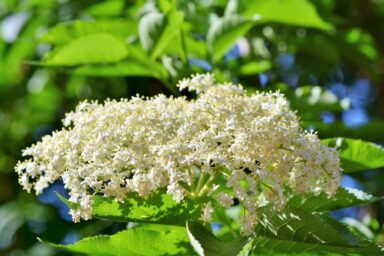
6. Elderflower (Sambucus canadensis)
Elderflower, or Sambucus canadensis, is a plant native to North America. Elderflower plants typically grow as shrubs or small trees, reaching heights of up to 12 feet.
Their leaves are arranged in opposite pairs with five to nine leaflets, while Yarrow’s leaves are divided and fern-like.
The beautiful flowers of the Elderflower are cream-colored and form sloping or domed clusters, much like yarrow, a fact that can lead to them being confused for one another especially when Elderflower is young.
But there are two big giveaways that you are dealing with Elderflower: its clusters tend to be larger, less dense and more rounded, and when in season, Elderflower will grow big clusters of plum, purple-black berries!
These berries have been harvested for food (after cooking) for ages, and are beloved in all sorts of sweet desserts and toppings, from pies and preserves to cookies and even for making wine!
And Elderflower is generally safe to handle, but raw berries contain toxins and should not be consumed without proper cooking!
7. Osha (Ligusticum porteri)
I am not talking about the workplace safety agency, here! Osha, also known as Ligusticum porteri, is a perennial herb that belongs to the carrot and parsley family.
Strictly a mountain plant, you’ll usually find it anywhere in a steep, hilly region between 4,000 and 10,000 feet. Otherwise you won’t find it, so if you aren’t assessing your Yarrow in the mountains, this one is off the table.
If you are, it’s easy to mistake Osha for Yarrow because they have similar growth habits and flower structure: Both produce clusters of small white flowers atop umbels.
But, look closely: Osha has fronds of carrot-like leaves, unlike the leaves of Yarrow which look very much like a miniature fern. Also watch for the above-ground parts of Osha die back in winter to a thick, woody, and fragrant root.
Osha is generally safe to handle, and has been a feature of ancient Native American healing practices for a long time.
But modern science shows its actual efficacy to be questionable compared to other plants we’ve talked about, so think twice before you try to make use of it.
You should also note that Osha is a slow-growing plant and wild-harvesting can threaten its populations, so only do so responsibly.
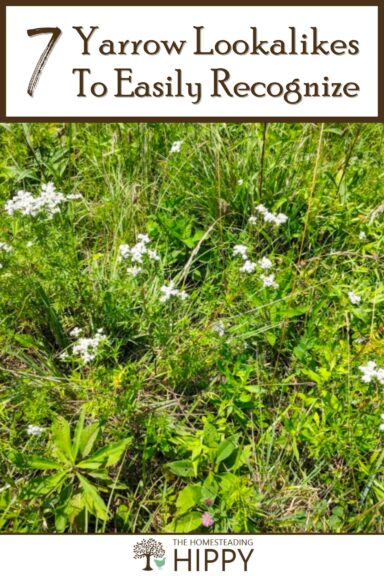
Tim is a farm boy with vast experience on homesteads, and with survival and prepping. He lives a self-reliant lifestyle along with his aging mother in a quiet and very conservative little town in Ohio. He teaches folks about security, prepping and self-sufficiency not just through his witty writing, but also in person.
Find out more about Tim and the rest of the crew here.
